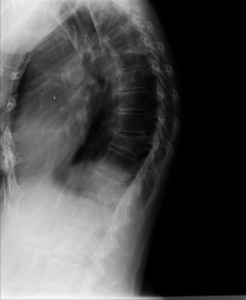
Kyphosis is commonly referred to as dowager’s hump. It is the deformity in the upper back that causes one to be bent forward. Although multiple problems may manifest as kyphosis, osteoporosis is the one most identified with this condition.
In osteoporosis, the cause is fractures in the upper or thoracic spine. The fractures are typically in a wedge shape that produces the bent forward posture. This wedge shape of an individual vertebra is a result of the front section decreasing in height relative to the back section. Usually, kyphosis occurs after multiple fractures rather than just one.
Deformity Associated with Many Problems
Kyphosis is associated with multiple problems. This physical deformity can be associated with pain from acute fractures or long-term muscle fatigue and pain. The physical rearrangement causes lung problems because of restriction by the ribs and collapse of spine levels; the bottom of the ribs in the front may end up sitting on the rim of the pelvis; eating can become a problem. Trying to find clothes that fit are a challenge. Psychological well-being may be impacted as part of physical disabilities.
Individuals with spine fractures are also at increased risk of death. Those with pain from their spine fractures have death rates similar to those who sustain hip fractures.
